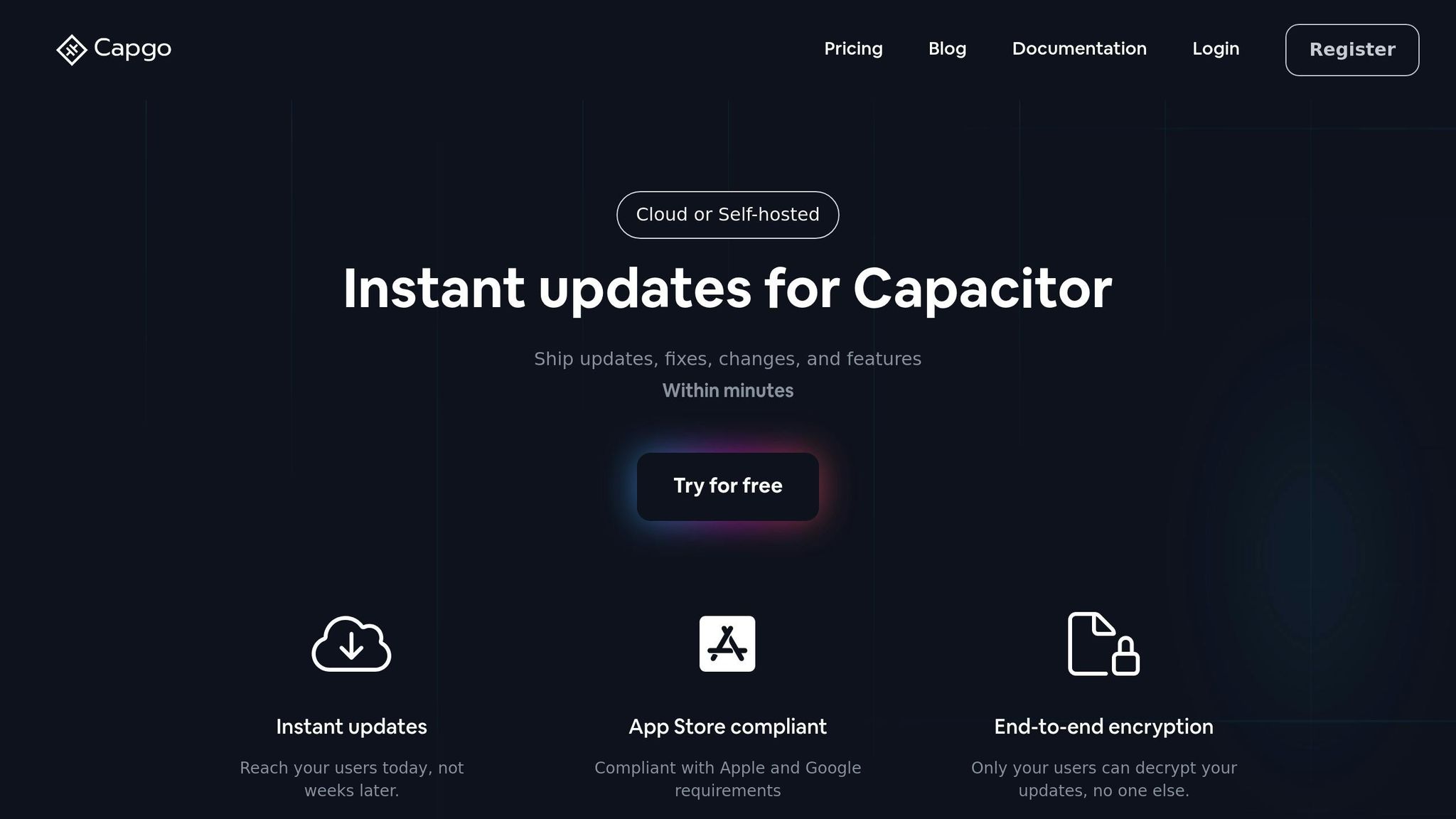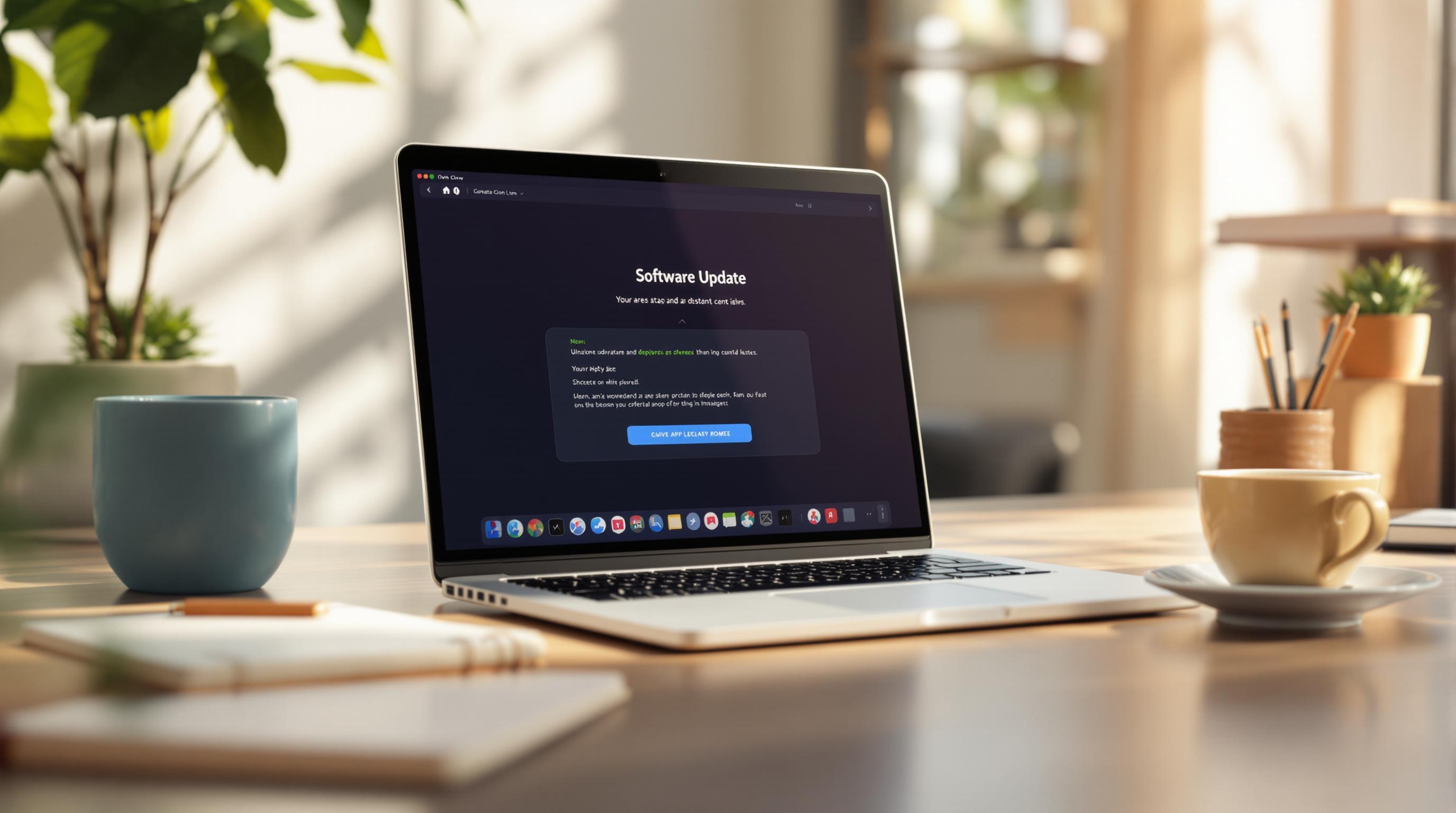Over-the-Air (OTA) updates allow developers to push app changes directly to users without requiring app store approvals. This speeds up bug fixes and feature rollouts, with 95% of active users receiving updates within 24 hours. However, without a proper staging environment, updates can fail, causing crashes or compatibility issues.
Why Staging Environments Matter
A staging environment helps test OTA updates before they go live. It mimics production settings, tracks update performance, and allows for quick rollbacks. Key benefits include:
- Testing on diverse devices and network conditions
- Real-time error tracking and monitoring
- Controlled rollouts to smaller user groups
Common Problems Staging Solves
| Problem | Impact | Solution |
|---|---|---|
| Compatibility issues | App crashes | Test on varied devices |
| Uneven performance | User complaints | Phased rollouts |
| Critical bugs | Poor user experience | Error monitoring and rollback |
Quick Setup Tips for Staging
- Match production settings (servers, databases, integrations).
- Use anonymized data for realistic testing.
- Automate builds with CI/CD pipelines.
- Test in phases: Alpha, Beta, and Release Candidate channels.
Tools for OTA Success
Platforms like Capgo simplify staging with features like encrypted updates, error tracking, and rollback options. With 750 apps in production and 23.5M updates delivered, it ensures updates are fast, secure, and reliable.
Key takeaway: A robust staging environment ensures smooth OTA updates, reducing risks and improving user experience.
Staging and Production Environment - Software Testing …
Building a Staging Environment
Setting up a staging environment is a must for testing OTA updates before rolling them out to production.
Key Components for a Staging Environment
To properly replicate your production environment, you’ll need the following components:
| Component | Purpose | Implementation Tips |
|---|---|---|
| Test Devices | Ensure device diversity | Include a mix of iOS and Android devices. |
| Network Simulator | Test under varied conditions | Configure bandwidth limits and latency. |
| Monitoring Tools | Track performance issues | Set up error logging and analytics tools. |
| Version Control | Manage updates | Use separate branches for staging. |
| CI/CD Pipeline | Automate deployments | Replicate production deployment workflows. |
Your staging environment should closely resemble production but remain isolated. Platforms like Capgo make this easier by offering dedicated testing channels, allowing for precise and reliable testing conditions.
How to Set Up a Staging Environment
Follow these steps to create and maintain a staging setup that mirrors your production environment:
-
Environment Configuration
Match your production settings, including servers, databases, and third-party integrations. -
Data Management
Use anonymized production data for testing. Refresh this data regularly to keep it realistic. -
Automation Integration
Implement a CI/CD pipeline that mirrors production. For example:- Automate builds, run integration tests, monitor performance, and enable rollback features.
-
Update Channel System
Divide your testing process into distinct phases:- Alpha channel: For developer testing.
- Beta channel: For internal team testing.
- Release candidate channel: For final pre-production checks.
Keep your staging environment in sync with production through regular updates and monitoring. This helps catch issues early and prevents discrepancies between the two environments.
OTA Update Testing Methods
Manual vs Automated Tests
Testing OTA updates involves both manual and automated approaches. Each method has its strengths, and combining them ensures thorough coverage.
| Testing Type | Best Used For | Key Tools/Approaches |
|---|---|---|
| Manual | Checking user experience, visual elements, and edge cases | Device testing, beta tester feedback, user flow assessments |
| Automated | Running regression tests, measuring performance, and simulating network conditions | CI/CD pipelines, automated test suites, load testing tools |
| Hybrid | Validating releases, testing new features, and ensuring rollback reliability | A mix of manual checks and automated safety processes |
Simulated network testing also plays a critical role by uncovering connectivity-related issues.
Testing Network Conditions
Testing under different network conditions ensures that OTA updates perform reliably:
-
Simulate Network Scenarios
- Test updates over 2G, 3G, 4G, and 5G networks.
- Check performance during intermittent connectivity.
- Verify that updates resume seamlessly after a connection is lost.
-
Monitor Performance Metrics
- Measure download speeds under varying conditions.
- Track how often updates complete successfully.
- Log bandwidth usage patterns for analysis.
For instance, Capgo optimizes updates by downloading only necessary changes, saving both bandwidth and time.
Error Handling and Recovery
Testing often uncovers issues that require robust recovery strategies to maintain app stability during OTA updates. Effective error handling is key.
| Error Type | Recovery Method | Method Details |
|---|---|---|
| Network Failure | Auto-retry mechanism | Use progressive backoff and resume updates from checkpoints. |
| Version Conflict | Rollback protocol | Allow one-click reversion while keeping user data intact. |
| Storage Issues | Space management practices | Perform pre-update checks and regular cleanups to free up space. |
Capgo provides tools for error tracking and analytics to streamline recovery efforts:
-
Monitoring Update Health
Track update success rates and identify potential problems early using real-time insights. -
Implementing Recovery Procedures
Roll back quickly to stable versions when issues arise, especially during staged rollouts. -
Managing Distribution Channels
Use dedicated channels for beta testing and staged rollouts. This approach minimizes risks by validating updates with smaller user groups before a full release.
OTA Update Management
Effective update management is the final piece of a successful OTA strategy. It ensures smooth deployment and builds on strong testing practices.
Reducing Update Size
To make updates smaller and less demanding on bandwidth, consider methods like delta updates, asset compression, and code minification. These techniques help streamline the process and improve user experience.
Phased Rollouts
A gradual release of updates, known as phased rollouts, helps minimize risks. By targeting specific groups, you can monitor performance and address issues before a full-scale release. Tools like Capgo’s channel system make this easier by allowing developers to distribute different update versions for beta testing or staged rollouts [1].
App Store Rules Compliance
Sticking to app store guidelines is crucial to avoid delays or disruptions during the review process. Both Apple and Google enforce strict security protocols, and tools like Capgo simplify this by ensuring updates align with these standards.
“App Store compliant” - Capgo [1]
Using Capgo for OTA Updates

Capgo Core Functions
Capgo simplifies the process of managing OTA updates with its secure, encrypted system and advanced channel functionality. Updates are delivered quickly and securely, thanks to its global CDN, which achieves a 114ms download time for 5MB bundles and an average API response time of 434ms worldwide [1]. The platform also uses a partial update system, downloading only the changed components. This approach has led to an impressive 95% update rate among active users within 24 hours [1].
Developer Advantages
Capgo provides a range of tools to make testing and deploying updates more efficient, especially in staging environments. It integrates seamlessly with CI/CD tools like GitHub Actions and GitLab CI, enabling instant deployments. Developers also benefit from its detailed error tracking and analytics, which offer insights into update performance. Key metrics include:
| Metric | Details |
|---|---|
| Update Success Rate | Tracks the percentage of successful installs in real time |
| User Engagement | Monitors how many active users adopt updates |
| Download Performance | Measures CDN response times and bandwidth usage |
| Error Logging | Provides detailed diagnostics for errors |
These features make Capgo a powerful tool for developers, enabling them to test and refine updates effectively.
Capgo Setup Steps
Getting started with Capgo for staging is simple. First, install the Capgo plugin using this command:
npx @capgo/cli initCapgo works with both Capacitor 6 and 7, ensuring it fits into various development workflows. For staging environments, follow these steps:
- Set up separate update channels for staging and production to keep environments distinct.
- Enable detailed error tracking to catch issues early.
- Use the one-click rollback feature to quickly revert updates if needed.
With 750 apps in production and 23.5 million updates delivered [1], Capgo has proven its reliability for managing OTA updates efficiently and securely.
Conclusion: OTA Update Guidelines
Key Testing Points
Testing OTA updates requires a structured approach to ensure both reliability and a smooth user experience. When done effectively, updates can reach a success rate of up to 82% [1]. Here are the primary areas to focus on during testing:
| Testing Requirement | Implementation Focus |
|---|---|
| Update Distribution | Controlled rollouts through channel-based deployment |
| Error Monitoring | Real-time tracking and diagnostic tools |
| Network Conditions | Testing under different connection speeds |
| Version Control | Separate staging and production environments |
| Rollback Protocol | Reliable rollback mechanisms to revert updates |
Practical examples highlight the importance of these priorities:
“We rolled out Capgo OTA updates in production for our user base of +5000. We’re seeing very smooth operation almost all our users are upto date within minutes of the OTA being deployed to @Capgo.” [1]
Next Steps
To make your OTA updates secure and efficient, consider these steps:
- Use encrypted delivery systems to meet security standards and app store requirements.
- Set up monitoring tools to track critical metrics in real time.
- Implement phased rollouts by starting with a small user group before expanding to all users.
A well-prepared staging environment, supported by platforms like Capgo, can help you achieve these goals. For instance, 95% of active users can update within 24 hours, with an average global API response time of 434ms [1].
“We practice agile development and @Capgo is mission-critical in delivering continuously to our users!” [1]




